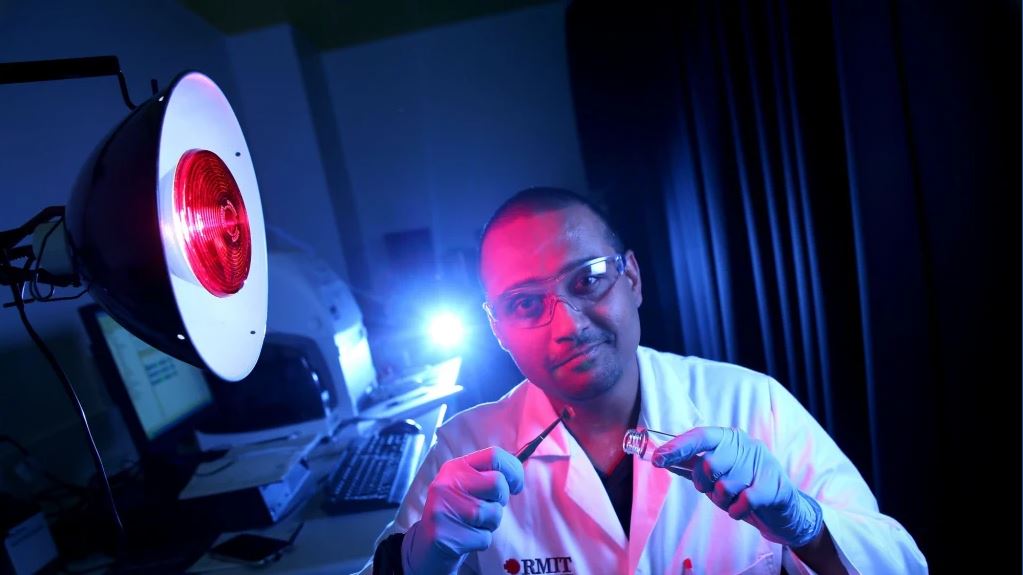Self-Cleaning Clothes, Wound-Healing Textiles and Real-Time Biological Imaging – The 2019 Phillip Law Postdoctoral Award

Successful commercialisation is a coveted indicator of impact for research institutions and Commonwealth funding schemes alike; it’s so much easier to demonstrate a return on investment from our research sector when our scientists produce knowledge products that influence markets and improve our quality of living. Yet too few outside the research trenches appreciate that breakthroughs with high market potential stand on the shoulders of many decades of investment in inquiry-led, or “pure” research. The work of thousands of scientists highly skilled in chemistry, physics, mathematics, engineering and biology has built a body of knowledge that now fuels our contemporary revolution in materials science. The incredible innovations being produced in both medical and domestic settings are the talented outputs of an accumulated wisdom and the blurring of disciplinary boundaries between fields of scientific inquiry.
Yet it falls to the current generation to interpret, interrogate and extend this vast and impossibly complex body of knowledge, recognising the relationships and patterns within to see the opportunities for new applications, waiting to be explored and activated.
With Dr Rajesh Ramanathan, we encounter a special example of a scholar exploring the knowledge base from traditionally separate fields of scientific inquiry. First trained as a biologist, Rajesh combined his PhD work in materials science to consolidate expertise across the chemical, physical and biological sciences, enabling him to develop and contribute to research projects across disciplinary boundaries. Rajesh’s interdisciplinary work is based on understanding the fundamental properties of nanoparticles – particles a billion times smaller than a metre – and exploiting these properties to develop a range of next-generation biomedical technologies. The focus of his research interfaces nanotechnology and biology, including sensor processes and diagnostics, antimicrobial and wound management and imaging applications to create a remarkable diversity of new applications and products with high commercial potential.
As always, our assessors worked diligently through a pile of applications that grows, year on year, commensurate with the growth in Victoria’s remarkable pool of talent in a vibrant field. In a typically competitive field, Dr Rajesh Ramanathan has emerged as the lead applicant and will be awarded the Phillip Law Postdoctoral Award for the Physical Sciences on the evening of Thursday, 24th October, where Rajesh will present us with an insight to his exciting work at a public lecture titled Nanoparticles: Exploiting Colour and Light.
The Society congratulates Dr Rajesh Ramanathan on being selected to receive the 2019 Phillip Law Postdoctoral Award for the Physical Sciences!
Dr Rajesh Ramanathan
 Dr Rajesh Ramanathan is a Senior Lecturer and co-lead of the NanoBiotechnology Research Laboratory (NBRL) at RMIT University‘s School of Science. His research in the area of bio-electrochemistry has led to the use of different bacteria as ‘nano-factories’ to achieve eco-friendly synthesis of nanoparticles. Dr Ramanathan employs electrochemistry to understand bio-geochemical processes within individual bacterial cells leading to the discovery of new enzymes involved in biogeochemical processes and gaining new insights into microbial biogeochemical pathways.
Dr Rajesh Ramanathan is a Senior Lecturer and co-lead of the NanoBiotechnology Research Laboratory (NBRL) at RMIT University‘s School of Science. His research in the area of bio-electrochemistry has led to the use of different bacteria as ‘nano-factories’ to achieve eco-friendly synthesis of nanoparticles. Dr Ramanathan employs electrochemistry to understand bio-geochemical processes within individual bacterial cells leading to the discovery of new enzymes involved in biogeochemical processes and gaining new insights into microbial biogeochemical pathways.
In addition to collaborations with CSIRO and other national research institutions, Dr Ramanathan has developed an extensive international network of collaborators at institutions such as University of Waterloo (Canada), Pacific Northwest National Laboratory (PNNL) (USA), University of Massachusetts (USA) and Martin Luther University (Germany). The high prospect for commercial applications in the biomedical space has resulted in his work being shortlisted as one of the Top 50 life-changing innovative designs by INDEX: Design to Improve Life Denmark (2017). He is also a recipient of numerous awards and prizes.
Rajesh attained his Bachelor of Science from the University of Mumbai, India before moving to Australia to pursue a Master of Biotechnology from RMIT. Following a brief stint in industry after his Master’s degree, Rajesh moved back to academia to complete his PhD in nanobiotechnology with RMIT and is now a Senior Lecturer within the School of Science. He is also the Treasurer for the Victorian Branch of the Royal Australian Chemical Institute (RACI).
* * *
Our thanks to all 2019 applicants, and to our assessors for working through a challenging field of applications. Dr Ramanathan will be presented with his award certificate and a prize of $3,000, and will share his work with our audience at the Royal Society of Victoria on the evening of Thursday, 24th October. Join us for “Nanoparticles: Exploiting Colour and Light” and help us to celebrate the accomplishments of this high-achieving, Victorian early career researcher.






